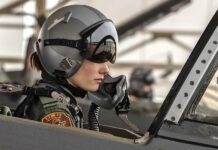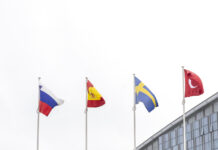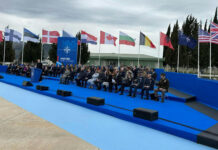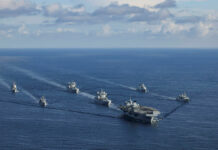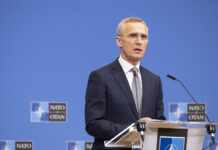Between 5 September and 9 October 2022, the autumn phase of the military training cycle “Namejs 2022” took place in Latvia. The focus this year was on the security of the Baltic States and Poland. In addition to national forces, the exercise included elements of the NATO enhanced Forward Presence (eFP) Battlegroups participating in NATO’s ‘Silver Arrow’ exercise.
Participants in the exercise included the Latvian Armed Forces and the National Guard, national security and civil protection forces, civilian industry, as well as international contingents from eFP BattleGroup from Latvia, reinforced by detachments from the neighbouring Estonia and Lithuania. From Lithuania, among others, a tank company of the German lead unit participated.
Namejs is a nationwide series of exercises that has been conducted regularly throughout Latvia since 2014. According to the Latvian Armed Forces, the objectives of the autumn phase of Namejs 2022 were further improving command and control (C2) of the national armed forces and strengthening cooperation between units. In addition, the exercise aimed to examine and deal with supply issues, and integrate procedures for air, sea, and land operations. The exercise included field tactical training for hybrid and conventional operations. The Latvian leadership wants their defence forces to be able to be capable of operating both independently and within the framework of collective defence.
The Ādaži barracks, located 25 km northeast of Riga and 250 km west of the Russian border, was used to house Latvian and allied troops. The barracks has been modernised and expanded since 2017, with over EUR 25 million spent on its modernisation in 2018 alone, and increasing to EUR 50 million annually in subsequent years, topped up by funding from the NATO Security Investment Program (NSIP) and the European Union. Since 2017 the barracks has hosted around 2,000 Latvian soldiers from the Latvian infantry brigade, as well as approximately 1,400 soldiers from eFP Battlegroup Latvia under Canadian leadership. Since March 2019, Ādaži has been the location of the NATO Multinational Division North (MND N), hosting units from Denmark, Germany, Estonia, Canada, Latvia and the USA.

Credit: Gerhard Heiming
NATO Exercise Silver Arrow
NATO exercise Silver Arrow 2022 took place at the Ādaži military training area, located in the middle of a wetland on the Gauja River, less than 20 kilometres from the Baltic Sea. During the exercise, multinational forces served as part of Latvia’s Mechanised Infantry Brigade, supported by the headquarters of NATO’s Multinational Division North, simulated engagements in wetlands and various other key positions. The Latvian Mechanised Infantry Brigade comprised more than 4,000 soldiers with over 1,000 combat, liaison, support and logistics vehicles from 17 of the 30 NATO member states.
To demonstrate a rapid response capability, the US Special Operations Force Europe provided two M142 High Mobility Artillery Rocket System (HIMARS) launchers at short notice for the exercise. The systems were flown in on a C-130J Commando II transport aircraft and stood by for two days to engage targets that could not be safely destroyed by the mechanised infantry force. The systems demonstrated their capabilities, conducting firing live fire at simulated targets in the Baltic Sea.
As part of the exercise, the forces conducted a refugee escort mission, with approximately one hundred refugees represented by journalists and visitors being transported in open-topped trucks. The refugee convoy was escorted by Italian security forces with Centauro II fire support vehicles and Iveco LMV protected reconnaissance vehicles. At one point the refugee convoy was required to conduct a gap-crossing exercise, using a pontoon bridge and then a ferry, both of which were operated by a Czech engineer unit, to overcome water obstacles which were protected by artillery, tanks and infantry fighting vehicles (IFVs). The planned air support was cancelled due to poor visibility, however the refugee convoy managed to reach safety after being ferried across the water with three trucks per ferry.
On 29 September, the final day of ‘Silver Arrow’, NATO troops demonstrated their combat capabilities and readiness within the framework of collective defence. The task of the exercise was to establish a bridgehead with armoured, infantry and engineer forces, with air support provided by combat helicopters and aircraft. After establishing a secure crossing, the forces advanced further and took key terrain under heavy fire, with Engineers conducting mine laying and facilitating crossings over small gaps in the terrain.
Results of the Exercises
The exercise was an impressive demonstration of the strength and combat capability of the Latvian armed forces in cooperation with the NATO eFP forces in Eastern Europe. In addition to technical skills, the exercise demonstrated the successful C2 of the international formation, with combined operations running smoothly and the planned operational objective achieved. This was also the conclusion of the leader of the exercise, the Latvian brigade commander, Colonel Sandris Gaugers. His brigade and the international eFP Battlegroup managed to quickly come together and complement one another’s capabilities. Latvia demonstrated that it has a combat unit ready for conducting both independent and joint operations.
The Parliamentary Secretary of the Latvian Ministry of Defence, Baiba Bļodniece, praised the international commitment of NATO forces to Latvia’s security as a building block for the security of Europe and NATO. Latvia depends on a strong defence in the Alliance, she said. The political situation in Ukraine and Belarus poses a threat not only to neighbouring countries like Latvia and the Baltic states, but also to the whole of Europe and NATO.
First test for the Patria 6×6
The equipment of the participants was highly varied, comprising Leopard 2 and PT-91 main battle tanks (MBTs), LAV 6 8×8s, Scimitar tracked reconnaissance vehicles, Mercedes-Benz G-class, and Iveco LMVs. Of note, Latvia’s new Patria 6×6 took part in the exercise shortly after the first deliveries, and was the newest vehicle present.

Credit: Gerhard Heiming
Since October 2021, the Latvian Infantry Brigade has received a good two dozen Patria 6×6 APCs from Finland, and Latvian industry is preparing for domestic production of the remaining contracted vehicles, out of a total of over 200. Deliveries of the vehicle are scheduled for completion in 2029, however, industry sources have stated that Latvia may order another 100 vehicles.
Jouko Jantunen, programme director at Patria said the company is presently working to increase the production rate of the vehicles, and added that many of the vehicle’s components were developed based on experience from the earlier Patria Armoured Modular Vehicle (AMV) 8×8 and other military vehicle developments. Jantunen cited ease of operation, adaptability to different roles and optimisation of life cycle costs as the most important goals in the development of the 6×6.
The first vehicles delivered are configured as APCs, with space for eight dismounts. Latvian troops have gained great confidence in the vehicle in the short time it has been in use, the crew reported. So far, the maintenance effort has been very low, and it is very easy to operate. In the field, the vehicle has been able to keep up well with tracked vehicles.
The Patria 6×6 is being further developed under the Finnish-led Common Armoured Vehicle System (CAVS) programme. So far, the programme members consist of Finland, Latvia, and Sweden, however, Germany and Estonia have also expressed interest in joining the programme.
Gerhard Heiming





